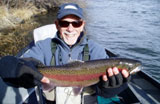Description
Hogan’s S & M Nymph was the star performer
at the recent Upper Sac outing….even
out-fishing Bill’s Stick Caddis, which is
generally the number one fish-getter at this
time of year. This year’s weather, being
warm with crisp blue skies and very low,
crystal clear water conditions, seems to
have affected the normally heavy October
Caddis hatch which, in turn, reduced the
effectiveness of October Caddis patterns
(larva, pupa, emerger, and adult). Many fish
were still caught on the Stick Caddis, but
the small nymphs clearly out-performed all
others—with the S & M leading the charge.
That’s the “bad news;” the “good news” is
that there were prolific hatches of
baetis, or blue winged olive mayflies.
BWOs are tiny grayish olive bugs, normally
imitated well by tiny Pheasant Tail nymphs.
The nymphs were active most of the day, but
particularly in low light conditions (early
morning, especially) and on days when there
was some cloud cover.
The S & M in various sizes probably imitates
a host of mayfly nymphs (and probably some
species of midges), but in the smaller sizes
(16-20) it is especially effective as a
baetis nymph imitation. My guide
clients, on Thursday, Friday, and Monday
were able to land many trout using this
pattern—with a few fish in the 18” range.
Outing participants also found it to be
particularly effective.
Since baetis hatch virtually all year
long, including Winter, let’s put a few of
these in our fly boxes.
Tying Instructions
|
|
1. De-barb the hook, add a 2 mm copper bead to
the hook, and cover the shank with
thread.
2. Using 5 or 6 pheasant tail barbules, tie in a
tail just above the back of the barb. At the
same spot tie in a piece of chartreuse wire.
|
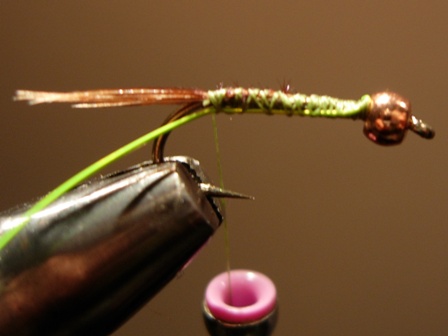
|
|
|
|
|
3. Tie in a few pheasant tail barbules by their
tips at the same spot. Wrap them
forward to the 1/3 point on the
shank and tie them off. This forms
the abdomen of the fly. Wrap the
wire rib forward in close turns and
tie it off at the front end of the
body.
|
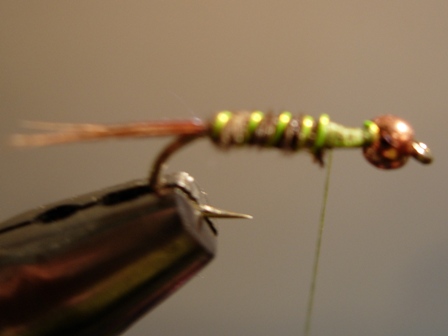 |
|
|
|
|
4. At the same spot, tie in a brown goose biot
with the butt end pointing rearward.
This will be used for the wing case.
5. Dub a small thorax in front of the abdomen.
|
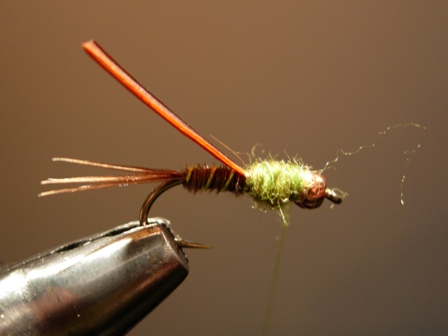 |
|
|
|
|
6. Tie in two short strands of pearl crystal
flash just behind the hook eye so
that there are two “legs” on each
side of the fly. The strands should
be pointing rearward. Clip the
crystal flash legs so that they end
at the point of the hook.
7. Apply a tiny drop of Dave’s Flexament or
similar glue to the top of the thorax and
quickly pull the biot over the top. Pull the
crystal flash legs rearward so that they lie
alongside the body of the fly. Tie off the
biot behind the eye of the hook and whip
finish.
|
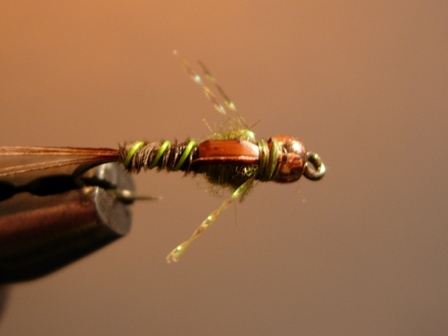 |
|
|
|
|
Tying
& Fishing Tips
1. I like to fish this fly on a 6” or 7” 4X dropper
protruding from the main tippet. I
use a loop knot to tie on the fly,
as it gives the fly more action in
the drift.
2. If you begin catching lots of fish on this fly, try
putting two of them on—one on the dropper and the other on the point fly—perhaps
using different sizes.
3. Fish this fly whenever you see BWOs flying around the
stream, or see their nymphs swimming about in the shallows.
Fish this delicate little bug
all year long—you won’t regret it. See ya on the creek. |
|
|
|
|
 |
|

